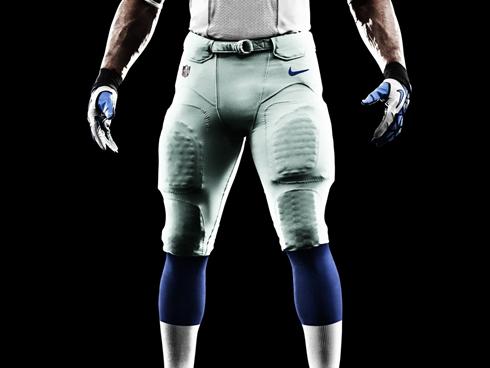After the National Football League implemented a new rule for 2013 mandating all players wear thigh pads, the league asked University of Virginia biomechanical researchers to test how well available thigh pads protected players against injuries.
“The league not only required the pads, but wanted to give the players some information to make smart decisions about which pads to use,” said Richard Kent, deputy director of U.Va.’s Center for Applied Biomechanics, a joint venture of the School of Engineering and Applied Science and the School of Medicine.
Based on recommendations and testing done by Kent and his colleagues from the biomechanics center, the NFL approved 37 thigh pads. Kent tested a total of 82 pads.
Kent compared whether a pad was better than a player’s bare thigh at preventing contusions and reducing pressure on the thigh following a hit “by dropping an impactor on [the pad] to simulate a hit.” He also developed recommendations for the size of the pad needed to effectively protect a player’s thigh.
The pads recommended by Kent and his colleagues added protection for the player.
Of the overall group of pads tested, some were no better than a bare thigh at protecting players against injuries, Kent said. Some of the pads increased the pressure on a thigh and made contusions and other injuries more likely.
While the Center for Applied Biomechanics is primarily focused on improving vehicle safety, Kent has also worked during the past six or seven years with the NFL on multiple research projects designed to improve player safety. Kent sees the work with the NFL as a natural extension of the center’s work on automotive safety – in both cases, researchers are looking for ways to protect against lower-limb injuries.
For example, Kent studied how far a football player’s toes could bend before suffering an injury commonly known as “turf toe” and how much a foot could twist before sustaining a Lisfranc fracture, a debilitating mid-foot injury. Kent has shared his research findings with the makers of football cleats and turf fields to help design equipment to reduce the risk for these injuries. New NFL-recommended practices on maintaining grass and artificial-turf fields are another product of Kent’s research.
“The fundamental science behind injury prevention is the same whether you’re protecting a driver or an athlete,” Kent said. “Once you understand what causes an injury, you can design effective countermeasures, set standards and guide policies. Just as research has driven continuous improvements in the designs of seatbelts and airbags, we can use the same tools to further protect athletes.”
Kent’s next football-related project is examining the biomechanics and potential steps to protect against high ankle sprains.
Media Contact
Article Information
August 23, 2013
/content/uva-researcher-leads-nfl-thigh-pad-testing-support-new-mandate

